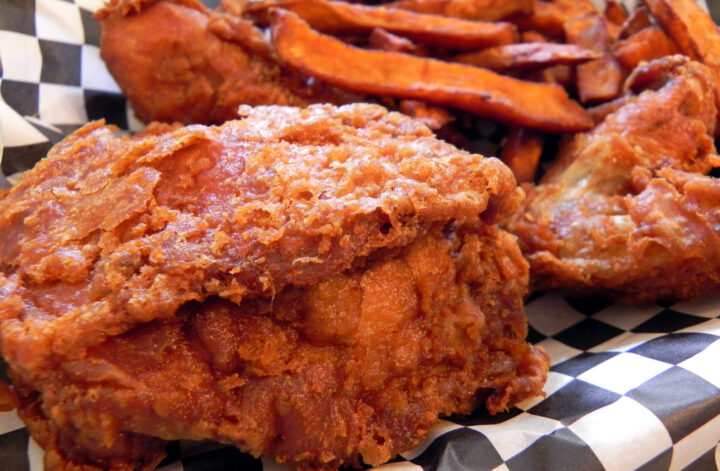“Interesting,” the woman murmured. Her gaze flicked back and forth between my face and the almost empty coffee cup in her hands. I had never met her before. She was strikingly beautiful with dark, almond-shaped eyes, black-brown hair and smooth, olive-toned skin. A friend of my aunt’s, she had been invited to celebrate Nowruz (Persian New Year) with us, feasting on dolmeh barg, ashe reshte and zereshk polow. We had finished dinner and were snacking on fresh fruit and pistachio taffy accompanied by piping hot Turkish coffee in tiny cups, a common after-dinner occurrence at my aunt’s house, when my aunt’s friend announced that she could “read” coffee grounds and would gladly do so for any there who wished it.
Draining my coffee in a gulp, I anxiously volunteered to be the first. Though I’ve never been a believer in fortune-telling or astrology, it’s always entertaining to hear what the practitioner might predict. My aunt’s friend (whose name I cannot recall) instructed me to turn the empty cup over so the grounds would drain and create a pattern she could decipher.

“You’re taking a long journey, one that will end very far from here,” she said while closely examining dried trails the muddy grounds left in my cup. I smiled, sure that someone else at the party had mentioned my impending move from the Bay Area. “This place will become a home to you, an area you will not wish to leave even though you may encounter great obstacles in your attempts to settle.”
Less than three months later, I packed up my things and made the move to New Orleans.
Over the past 15 years, my love for the Crescent City has only gotten stronger, though there are still things I miss about the Bay Area. Mission-style burritos, the deep booming sound of the crashing surf, real sourdough bread, hanging out with my family and Persian food are among the things I ache for the most, including my Armenian aunt’s late-night Turkish coffee.
Dating back to the 16th century, Turkish coffee is what it is because of the process used to brew it. Just like espresso, hot drip or nitro, it’s the method that makes the brew. In the case of Turkish coffee, dark-roasted coffee beans are finely ground, more so than espresso, to practically a powder. Using a “cezve,” traditionally a small copper pot with an unusually long handle, the ground coffee and water is brought almost to the boiling point and simmered (with sugar if you prefer) until the grounds begin to froth. The finished coffee is poured into small, espresso-like cups, making sure each cup has a bit of the froth on top. This extremely bitter brew is often served with sweets, whether its a square of rose water and honey-laden baklava or a cube of Turkish Delight.

Due to a glaring lack of Persian or Turkish (or even Armenian) restaurants in the Deep South, I was shocked to discover that the country’s foremost expert on Turkish coffee lives right here in New Orleans. Turgay Yidizli, winner of many coffee-related awards including the 2013/2014 World Cezve/Ibrik Championship, is the owner of Specialty Turkish Coffee, an online retail company selling specialized equipment created by Yidilzi to ensure the best cup possible.
“Turkish coffee tends to have a better cultural significance than it does flavor,” says Yidilzi. “Over the past century, it is something that is consumed daily, sometimes five or ten times a day, so it’s also inexpensive.” He explained that since the coffee is meant to be affordable, the most popular brands of Turkish coffee like Kurukahveci Mehmet Efendi (one of the most common Turkish coffees) use low quality beans. “Over the years, the ritual around making and drinking Turkish coffee became more important than the quality itself,” says Yidilzi. “People started adding sugar and other spices to balance the bitter flavor.”
Turkish coffee has also evolved to reflect the politics of the regions in which it’s served. For example, in Armenia you would call it “Armenian coffee” considering the Ottoman Empire committed genocide against the Armenians between 1915 and 1923, killing over a million people. In Greece, it’s Greek coffee. In Bosnia, it’s Bosnian coffee. But regardless where you’re consuming it or what you call it, Turkish quality has long been brewed from cheap, poor quality Brazilian coffee beans.

Political and nationalistic intrigue aside, the most important aspect of this rich, heady beverage according to Yidilzi should be the quality. After traveling widely and researching different coffee cultures all over the world, extensive barista training and competing in coffee-making competitions, Yidilzi turned his focus on creating the equipment and methodology that would, in his estimation, improve the overall quality, flavor and experience of Turkish coffee. “When I asked other coffee-lovers their opinions on Turkish coffee, they always fell back on its tradition and history,” says Yidilzi. “But when I asked specifically what they thought of the flavor, people always said it was too bitter.”
According to Yidilzi, as well as other seasoned coffee aficionados, the bitterness in a bad cup of coffee (caused by everything from bean quality and roasting methods to over-extraction) only hides the true, delicious flavors that coffee can have. Whether it be fruity, chocolaty or nutty, Yidilzi wanted to enjoy the traditions around Turkish coffee while simultaneously having a great cup of coffee.
“You will discover in this new place a life-long career and you will also meet a young man who will capture your heart. You will never been exceedingly rich, but you will always posses a wealth of love and happiness.” The woman handed the cup back to me and smiled quite knowingly while everyone around the table laughed good-naturally at my fortuitous future. Who would’ve guessed she’d be right?
Local spots to enjoy Turkish coffee!
Cleo’s Mediterranean Cuisine & Grocery
*Article originally published in the March 2018 issue of Where Y’at Magazine



